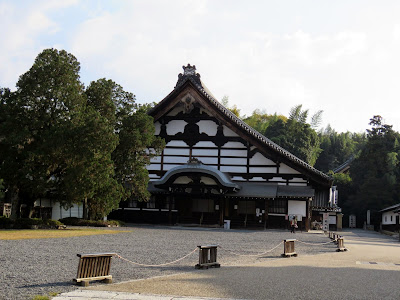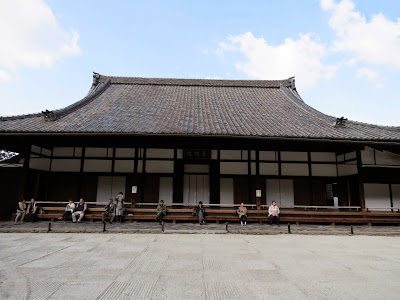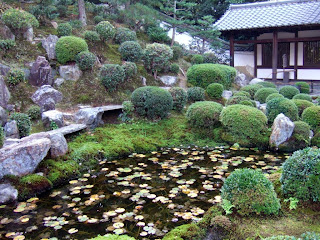
Tofuku-ji Temple is the head temple of Tofukuji School of Japanese Rinzai Sect Zen Buddhism and one of the five great Zen temples in Kyoto City. The temple situates at southern side of the city, was established during Kamakura period (1185-1333) by Kujo Michiie also known as Fujiwara no Kanezane (1193-1252) who was then the most powerful Statesman. He started building the temple to pray for the soul of his late grandfather in year 1236 and completed the construction 19 years later in 1255. He made the temple the largest in Kyoto and named it as Tofuku-ji by using the first two Kanji characters each from Nara's two great temple Todai-ji and Kofuku-ji. Master Enni Benen (1202-1280) was assigned as a founding Abbot in year 1243 and a 15 meters high Buddha Image was enshrined in the main hall. Most of the past buildings were burnt down in fires happened successively in 14th century and restored to its origin form by various influencing leaders. Several structures that restored in 15th century survived the ravages in wars and fires till today.


Wooden Sanmon Gate and Hondo Buddha Hall are two massive structures in the temple grounds. The 22 meters high two storey Sanmon Gate rebuilt in year 1425 is one of the oldest and most gorgeous Zen Temple Gate in Kyoto. It has been designated as Japan's national treasure building since 1952. The Hondo Main Buddha Hall that was restored in 1347 was again burnt into ashes with other buildings in 1881 fire. The present building was rebuilt in year 1934 but it retains a characteristic feature of a medieval Zen Temple.


Enshrined in the Main Hondo Hall is an auspicious Image of Buddha Vairocana (Pilu) attended by two Bodhisattva.


The famous dragon fresco Soryu-zu at the ceiling of Main Hall was a symbol of a temple's high ranking.



The national treasure Sanmon-gate went through a large scale of renovation and refurbishing works in 1969-1978. The cost of this nine years repairing works was up to 2.5 million of dollars.


Even though the scale of Tofuku-ji temple was reduced during the Meiji anti-Buddhism period (1868-1912), there are still about 25 large halls remained on its ground withstanding the test of time.


Structures surrounded Sanmon Gate and Hondo Main Hall including Shoro belfry, Zendo Meditation Hall and Tosu Lavatroy Hall, are buildings date back to early Muromachi Period (1333-1573). They are rare examples of Zen architecture survived from that era.



Yokushitsu steam bath is also an important property at grounds survived from 14th century.



The steam bath house was a 14th century architecture. .


Torii gates near the steam bath house leads to the 13 tiers stone pagoda.


Many treasures and historical artifacts are displayed inside Ryougnau Treasure Hall. It was specially opened for public in fall season.



Kuri (ancient kitchen) serves as an entrance to The building of Hojo which was established in year 1236 and restored in 1890. The four gardens surrounded the Abbot's former residence, were laid out in 1939 by famous garden builder Mirei Shigemori (1896-1975) who input the modern factors into style of Kamakura period (1185-1333)yet expressed the simplicity of Zen philosophy. Each garden has its own character.


To enter and admire the four unique and gorgeous gardens Hasso-no-niwa in Hojo Building, a separate admission fee of 400 yen has to be paid.


Hojo Tatami Room and its veranda has the best view of Karesansui dry garden.


Southern Dry Garden laid out in front of Hojo Building is the most contrived work among the four gardens. It composed of 4 rock composites placing from east to west on Hokkai sand gravel symbolizing Elysian islands on the 8 rough seas. The five moss covered earth mounds at the far right corner represented sacred mountains.


The four islands Eiju, Horai, Koryo and Hojo were represented by groups of huge rocks.



The moss covered earth mounds Tsukiyana are the sacred mountains in the garden laid out.


Building of Kuri (ancient Kitchen) was restored in year 1910 after burnt down in 1881.


Garden of the Big Dipper Hokuto-Shichisei-no-niwa at east side, has 7 cylindrical stones arranged in the moss field. These original foundation stones from other parts of the temple grounds, are said to represent the main stars of Great Bear of Heaven.



The West Garden has several moss and azalea shrubs trimmed in square and other irregular pattern known as Seiden-Ichimatsu, a Chinese style of dividing land.


Spread over North Garden are square cut stones and moss distributed in small sizes checkered pattern. The Garden faces the direction of Tsuten Bridge and Gorge, a place popular for its fall foliage sight.



An extraordinary awesome green garden!




We were impressed!


There are more than ten sub-temples within the temple grounds. Most of them were built by devotees in memory of their masters or family members.



The walls that circled up the building of Hojo and its beautiful gardens.


The skillfully pruned pine trees at the external compound of Abbot's former residence Hojo and Kuri Hall.



Sengyokukan Valley which is very popular for its autumn leaves, stretches on the north end of Hojo Building.



The covered corridors that connects Tsutenkyo Bridge to Kaisando Hall.


Valley up to Kaisando Hall is spanned by three bridges offering the most attractive foliage sight in the temple grounds.


The covered corridors




Kaisando Hall lies in the very north of the temple grounds.



The Halls of Kaisando and Fumon-in with its gardens were restored during Edo period (1603-1867)


The buildings of Kaisan-do and Fumon-in.


Kaisando Hall serves as a mausoleum to the first head priest of the temple.



There are two contrasting gardens flanked on both sides of central stone walkway in front of Kaisando Hall. The sand gravel dry garden was laid in front of Fumon-in on the left side.


A lush pond garden was laid out on a slope on its right side.



The entrance gate of Kaisan-do and the wooded forest behind pond garden.


A ground of striking green moss and the gentle red leaves at site.


Sunlight decides the color for the leaves.



The tradition fermented rice soup and its ginger cookies selling at temple ground are so good to eat that made us regret for not ordering a large one.



No comments:
Post a Comment